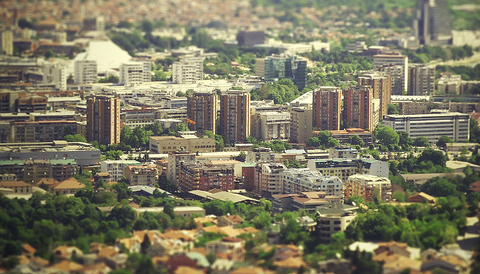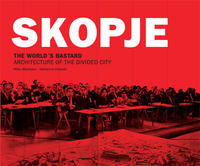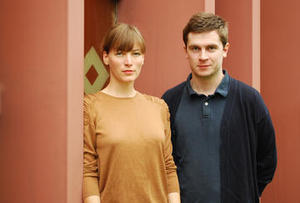
Skopje (Goce Mitevski/flickr)
Skopje, the capital of Macedonia, is a divided city but it retains a 'bastard' soul. Katharina Urbanek and Milan Mijalkovic have dedicated a book to it, looking into the meaning of the deep transformations - spatial and symbolic - that the city is currently undergoing with the controversial "Skopje 2014" plan. Our interview
How did you become interested in the Skopje '2014 Project'?
For us, it didn´t really start with the big project of “Skopje 2014” (which was officially presented only in the Spring of 2010) but from a general curiosity about this city. Our first real interest began with an architectural competition for an Orthodox church on Skopje´s main square in 2008.
In the context of the “divided city”, which is how see Skopje today, this project touched some very sensitive issues. Churches and mosques, crosses and minarets are part of the process of identity building that is taking place in Macedonia these days. So, there was a huge emotional discussion going on about this sacralisation of the city centre or the public space in general - which eventually even led to violence. As architects, it was very interesting to follow what was happening in the city, the intention of the government and the way people were reacting to the proposals.
Taking part in the architectural competition, it seemed to me then that this young democracy full with conflicts offers considerable potential for re-definitions of all kinds. I proposed a temporary church which is on one side very aggressive in occupying the square, and also quite monumental, but on the other side very light and vulnerable. The space that the project proposes, doesn´t first and foremost evolve from the idea of a church but from that of a conflict. And that conflict is indeed prolonged through the project - so that the space always asks for new consensus… and produces new conflicts.
We started to see conflicts as a potential – if we can manage to deal with them in a productive way, and if we make the space to do that. That's why we wrote the book. You have to know the conflicts, to analyse them, in order to use them in a thoughtful way.
Milan grew up in Skopje and thus he has a personal relation to the city. I wanted to bring a more detached point of view. The things that are going on in Skopje today are very interesting but they are not really an issue internationally. We wanted to provide the kind of knowledge which could be read by everybody. The book “Skopje. The World´s Bastard” does not give answers to what is happening, to the conflicts in this city – rather it proposes some new interpretations.
What kind of conflicts do you mean?
As architects, we are interested in the spatial manifestation of social conflicts. And in many of the projects that are being built at the moment under the title of “Skopje 2014” these conflicts do emerge.
The memorials, the monuments which are being built, dedicated for example to Alexander the Great, or Goce Delchev, are actually very political. They are very realistic in style – but in fact they are tell only part of the truth. Let's take for example the monument of Alexander the Great: it is huge and golden, it has a sword, but it shows only a small part of the conflict: there's no indication of how the Greeks, or the Albanians, see this character, or what kind of significance these figures have for all the communities which share the same territory and the same history. One illustration of this is when they built the monuments of Goce Delchev and Tsar Samuil, a Bulgarian minister said that he was very satisfied that a Bulgarian personality was being commemorated in Skopje. While Greece is complaining that their history is being stolen with the installation of the monuments of Alexander the Great and his father Philip.
Do you mean Skopje 2014 is not going to represent the multiculturality of Skopje, and of Macedonia?
Modern Skopje is actually a product of the idea of multiculturality. After the earthquake of 1963 the city was rebuilt by the UN (with Russia and the US participating side by side) and the Yugoslav government. It was declared an “open city”, open to different cultures, to migrants from everywhere. In the time of the Cold War Skopje, as an open city, became an original idea and an example for the world. Of course there had been a culture of living together long before that…Multiculturalism is in fact the culture of Skopje.
The problem with “Skopje 2014” is the trivialisation of this culture. Instead of originality and exemplarity, the city, or rather the political structure, has followed a strategy of imitation.
Identity is shaped by the distinction from “the Other” – inside and outside Macedonia. For example when – as a reaction to the proposed Orthodox church on the main square – Albanians want to reconstruct a mosque in the same square, Macedonians answered that under the mosque there used to be a church. In the end, neither a church nor a mosque will be built, there will be a lot of provocation, and limits will be tested.
At the same time, “Skopje 2014” is trying to establish a European version of local history. The whole process has been justified by saying: that´s the European way of thinking. Every European city has sculptures, but we don't. Every European city has a church in the centre, we don't. So we need all that, to define ourselves as Europeans. But this is not a new phenomenon in Skopje. It actually started with the fall of the Ottoman Empire. During the period when Macedonia was part of the Kingdom of Serbs, Croats and Slovenes, the modernisation and Europeanisation of the architecture in the city was the main tendency, which preferred a Western identity, to an Ottoman one. What is happening now is in essence similar to that trend. And in some ways it seems that the intended Europeanisation abandons the idea of multiculturality.
But Albanians, for example will play their part in Skopje 2014. Some monuments will be placed in the Albanian part of the city as well. So, it seems Skopje 2014 preserves the multicultural structure of the city...
Wealth, an important part of our culture, has largely been achieved through exchange and the points where different communities and their cultures overlap – even in a situation of (productive) conflict – have often been the most fruitful ones. It is interesting to notice that in this project, with reference to identities, Macedonians are looking at the ancient period and Albanians the Ottoman time. Each group chooses its own heroes and, by erecting monuments, marks its territory. Identities are being kept separate, as are histories. What is happening now is an attempt to trivialise history - and to avoid contact.
So, Skopje will keep being a divided city?
As a reaction to the whole issue of the appropriation of the main square, another project has been introduced. In the northern part of the city, which is mostly inhabited by the Albanians, another main square is planned. So, Skopje will be a city with two representative main squares. Symbolically, a city couldn´t be much more divided. Everybody has his space, and his sculptures, less sculptures in the Albanian case. Public space will be partitioned between Macedonians and Albanians and will be guarded by the respective historical figures – while other groups, such as the large Roma community, are under-represented
After the earthquake of 1963 and the reconstruction of the city centre by Kenzo Tange up until Skopje 2014, the main square used to be an empty dysfunctional space, where nothing really happened. This whole area enforced the division between the two parts of the city, but it was still a place that belonged to no-one and everyone at the same time. And even though a lot of construction work is going on at the moment, this will not change much. Overloading the former non-space with selective stories and symbols will not transform it into a vital space. Rather it will emphasise the dividing line.
That is a pity, because this former no man´s land could offer the ground to work with the conflict productively – with the aim that people perceive, express themselves and interact, living a common urban life.
Skopje is a divided city, but an interesting phenomenon has occurred recently. The čaršija/çarshija, which was for the last twenty years a Muslim (Albanian) space, is becoming increasingly interesting to Macedonians. And Macedonians are going out there and opening commercial activities in the bazaar. How do you see this kind of transformation?
This is a process that is just happening - as is normal in the development of a city. Some processes just occur, not everything is controlled, or planned. And often these processes are the most vital ones.
The old bazaar is the only area in the city centre not to be included in “Skopje 2014”. And – unlike to the “European” city components - there's no obvious politicisation of the old Ottoman bazaar, which remains more or less the same as it was historically. Actually, at the moment, when the whole centre is one huge construction site, this is the only place where you can have some peace. So people just escape from the rest of the centre. But it is a very casual process, the Government didn't plan it.
Do you think that the new buildings, and the project “Skopje 2014” fits in the centre of Skopje? In terms of materials, styles, urban history?
From the architectural point of view “Skopje 2014” is a very complex issue. However, we cannot answer this question, or we do not want to. We think that the topics that are usually discussed amongst architects – is it the right style that has been used, the right material, is the height proper or the positioning of the building – are in this case not the most important questions. What seems to us to be of greater importance is the choice or the conception of the functions to be housed by the new buildings.
And how do you find “Skopje 2014” from this point of view?
We made a comparison between the new archive in Skopje and what is said to be the first western archive in ancient Athens. And we noticed that not much has changed. “Skopje 2014” is only trying to interpret historical functions, without questioning or rethinking what - for example - an archive could be in Skopje, in a divided city, today. The new buildings will become governmental institutions with great façades, mainly to be seen from the outside, to demonstrate power, to be admired. And not to be lived in – which means in the end not to function. Especially not to function as the spaces of a young democracy could. This lack of functionality - in a broader sense - is not only the result of incompetence but also of the intentional avoidance of spaces where democracy would be practised and developed.
But how are people reacting to that?
The last elections showed that the government is very popular. People are split on the whole project, but the majority of them think that after twenty years of transition they deserve “Skopje 2014”. After all something bigger is happening. We think that people in Skopje deserve much more: not to feel inferior in their city. It seems there is a certain inferiority complex involved in “Skopje 2014”, the fear of not being European enough. This fear, or complex, is the result of an internalisation of the traditional external - Western - view of the Balkan as something incomplete. Although at first glance “Skopje 2014” aims to strengthen the Macedonian identity and the people´s belief in it, we think that it does exactly the opposite. By fulfilling all the clichés of a European city, “Skopje 2014” is actually questioning Skopje´s – and Macedonia’s – integrity.
Indeed, by Europeans this project is seen as banal. We think that the government in Skopje knows about that external perception, but they are trying to emphasise this banality even more - to gain attention. Attention that is strongly needed.
How will you perceive the city in 2014, when the project will have materialised in the centre of Skopje?
The title of the project is only a number, a date. It already tries to establish the year 2014 as an important historical moment, something unique and unforgettable. It suggests that by that time Skopje will have entered a new era, it will have been transformed into a new entity, the mission completed. Of course, this is a fiction. Development will continue – and thus we will perceive the city the same way we do today: as a bastard.
Why did you call your book “Skopje. The World’s Bastard”?
The bastard is a heterogeneous and multi-layered character. It can choose its identity according to the actual circumstances. Of course, the term signifies an anomaly but on the other hand it speaks of strength and independence. Skopje has the freedom to have many identities. But trying to Europeanise it in this way and thus choosing one highly defined identity the city loses part of its strength.
It is crucial to develop an awareness of the essence of Skopje, for its real qualities. When we call Skopje the “bastard”, everybody can choose what that means, and how they understand it. Anyhow, there should be space for debate and argument, for choosing and abolishing, for inventing and neglecting the city´s identities. City Planning should definitely integrate these spaces of conflict and negotiation, it should let the bastard in!









 To Top
To Top